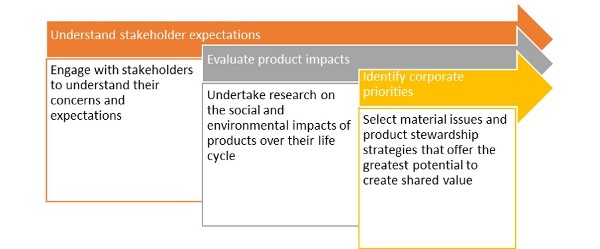Advances in Project Management Series
SERIES ARTICLE
By Dr Helen Lewis
Sydney, Australia
Introduction
Product stewardship is no longer a discretionary activity confined to businesses that want to ‘do the right thing’. There is growing government and consumer interest in the social and environmental impacts of products, from their supply chain through to end of life. This represents both a risk and an opportunity for businesses that make, sell or recover products.
Most product stewardship programs are a reaction to regulations or pressure from external groups. Responsiveness to stakeholder expectations on issues such as worker safety, hazardous substances and recycling can be beneficial, for example by improving a company’s reputation. A more proactive and strategic approach is to look for opportunities that create ‘shared value’: that simultaneously achieve social and environmental objectives while building long-term competitiveness.[i]
This article presents a strategic, shared value approach to product stewardship. It can be used by companies to reduce the life cycle impacts of their products while building business value, for example by reducing costs, improving access to raw materials or building customer loyalty.
Drivers for product stewardship
While product stewardship is often driven by stakeholder perceptions or expectations about a specific issue in the product life cycle, a more strategic approach also considers the available scientific evidence and how stakeholder concerns interact with business priorities. As Porter and Kramer argue, stakeholder views are important, but:
…these groups can never understand a corporation’s capabilities, competitive positioning, or the trade-offs it must make. Nor does the vehemence of a stakeholder group necessarily signify the importance of an issue—either to the company or to the world.[ii]
In practice most companies are driven to act by a combination of factors, including stakeholder expectations, evidence of product impacts and business goals and priorities. A systematic approach to product stewardship involves careful evaluation of all three drivers to guide decision making within firms (Error! Reference source not found.).
Figure 1: Three steps towards a product stewardship strategy

The following section considers each one of the three drivers for product stewardship individually: stakeholders, product research, and business priorities.
More…
To read entire article, click here
Editor’s note: The Advances in Project Management series includes articles by authors of program and project management books published by Routledge worldwide. Information about Routledge project management books can be found here.
How to cite this paper: Lewis, H. (2019). A Strategic Approach to Product Stewardship, PM World Journal, Vol. VIII, Issue VII, August. Available online at https://pmworldlibrary.net/wp-content/uploads/2019/08/pmwj84-Aug2019-Lewis-a-strategic-approach-to-product-stewardship.pdf
About the Author

Dr Helen Lewis
Principal, Helen Lewis Research
Sydney, Australia
![]()
Dr Helen Lewis runs her own consulting business, providing research and strategic advice to a range of industry and government clients on product stewardship and packaging. She is an Adjunct Professor with the Institute for Sustainable Futures (ISF) at the University of Technology Sydney and a consultant to the Australian Packaging Covenant Organisation (APCO). IN 2017 Helen co-founded the Product Stewardship Cluster to promote knowledge sharing and collaboration between product stewardship organisations.
Helen has written widely on product stewardship and corporate social responsibility including several books. She published Product stewardship in action in 2016 and is a co-author of Packaging for sustainability (2012) and Design + Environment (2001). She has a PhD in product stewardship and is a Fellow of the Australian Institute of Packaging.
[i] Porter, M., & Kramer, M. (2011). The big idea: Creating shared value. Harvard Business Review. Retrieved from https://hbr.org/2011/01/the-big-idea-creating-shared-value
[ii] Porter, M., & Kramer, M. (2006, December). Strategy and society: the link between competitive advantage and corporate social responsibility. Harvard Business Review, pp. 1-16 (p. 8).









